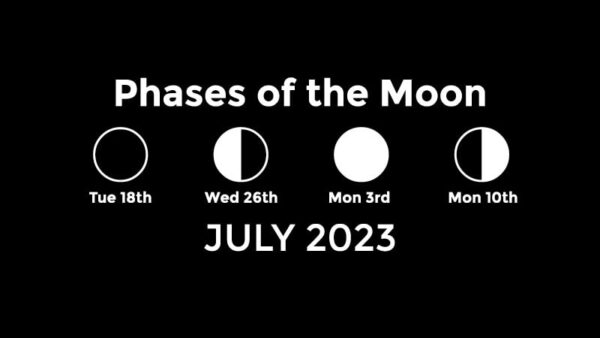Find out what to go out and look at this month
Planets:
Mercury will make its reappearance in the second week of July, appearing very low on the western horizon. It will begin the week situated in the constellation of Cancer (The Crab), but as the month progresses, it will transition into the constellation of Leo (The Lion), drawing nearer to Venus and the star Regulus. Venus can be observed in close proximity to Mars, positioned low in the constellation of Leo until the middle of the month when they gradually separate in the night sky. Meanwhile, Mars will continue its journey through the constellation of Leo, reaching its hind feet by the end of July.
Jupiter can be located between the head of the constellation of Cetus (The Sea Monster) and the front feet of the constellation of Aries (The Ram) during night-time. Saturn is also visible in the middle of the constellation of Aquarius (The Water-Bearer) in the night sky. Uranus rises late at night within the constellations of Taurus (The Bull), precisely positioned between Jupiter and the Pleiades Cluster. Lastly, Neptune can be found during the early night-time hours, situated between the top fish in the constellation of Pisces (The Fish) and the tail of the constellation of Cetus.
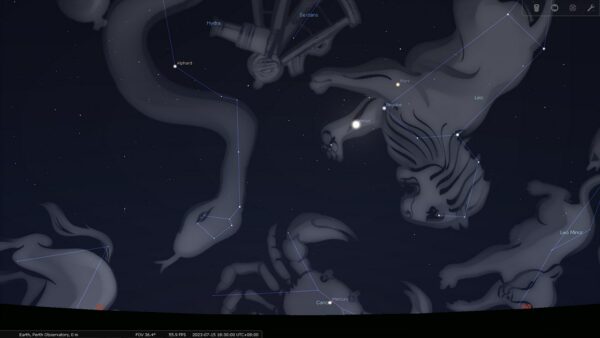
|
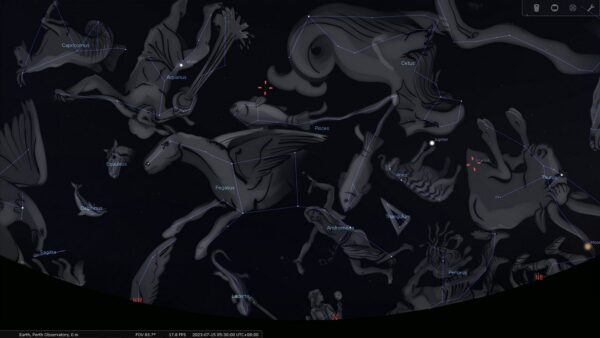
|
| Planet | When It Rises Or Sets |
|---|---|
| Mercury | At the start of July, it’s not visible as it’s in the Sun’s glare, and by the end of the month, it’ll set at 07:38 pm (AWST) |
| Venus | At the start of July, it sets at 08:37 pm (AWST), and by the end of the month, it’ll set at 07:14 pm (AWST) |
| Mars | At the start of July, it sets at 08:53 pm (AWST), and by the end of the month, it’ll set at 08:22 pm (AWST) |
| Jupiter | At the start of July, it rises at 02:41 am (AWST), and by the end of the month, it’ll rise at 1:04 am (AWST) |
| Saturn | At the start of July, it rises at 9:50 pm (AWST), and by the end of the month, it’ll rise at 07:42 pm (AWST) |
| Uranus | At the start of July, it rises at 03:42 am (AWST), and by the end of the month, it’ll rise at 01:49 am (AWST) |
| Neptune | At the start of July, it rises at 11:27 pm (AWST), and by the end of the month, it’ll rise at 9:24 pm (AWST) |
Conjunctions And Occultations:
Conjunctions involve object(s) in the Solar System and/or more distant objects, such as a star. It’s an apparent phenomenon in which multiple objects which aren’t close together appear close in the sky and it’s caused by the observer’s perspective.
In an occultation, an object passes across the line of sight between an observer and another object. A solar eclipse is an occultation of the Sun by the Moon.
- 01/07/23 – Conjunction of Venus and Mars (Where to look)
- 01/07/23 – Conjunction of The Moon and Antares (Where to look)
- 07/07/23 – Conjunction of The Moon and Saturn (Where to look)
- 10/07/23 – Conjunction of Venus, Mars, and Regulus (Where to look)
- 12/07/23 – Conjunction of The Moon and Jupiter (Where to look)
- 13/07/23 – Conjunction of The Moon and Pleiades (Where to look)
- 14/07/23 – Conjunction of The Moon, Aldebaran, and Pleiades (Where to look)
- 14/07/23 – Conjunction of Venus, Mars, and Regulus (Where to look)
- 19/07/23 – Conjunction of The Moon, Mercury, Venus, Mars, and Regulus (Where to look)
- 20/07/23 – Conjunction of The Moon, Mercury, Venus, Mars, and Regulus (Where to look)
- 21/07/23 – Conjunction of The Moon, Mercury, Venus, Mars, and Regulus (Where to look)
- 25/07/23 – Conjunction of The Moon and Spica (Where to look)
- 28/07/23 – Conjunction of The Moon and Antares (Where to look)
Astronomical Events This Month:
The Delta Aquarids:
The Delta Aquarids meteor shower is set to reach its peak on the night of July 30th/31st, primarily favouring observers in the southern hemisphere, including those in Perth. This captivating shower remains active from July 12th to August 23rd, with the number of meteors seen per hour varying between 10 to 20. However, in 2023, the presence of a Full Moon in the night sky will result in reduced visibility of meteors from this shower.
The radiant point for the Delta Aquarids lies within the constellation of Aquarius, becoming visible from 08:00 pm (AWST) on the 30th. For optimal viewing, it is advisable to wait until around 03:00 am on August 1st. Although the Delta Aquarids lack a prominent peak, they consistently grace the night sky with their presence throughout their active period. It is believed that the comet 96P/Machholz 1, once part of the ancient stream of Kreutz Sungrazing comets, serves as the source for the Delta Aquariids.
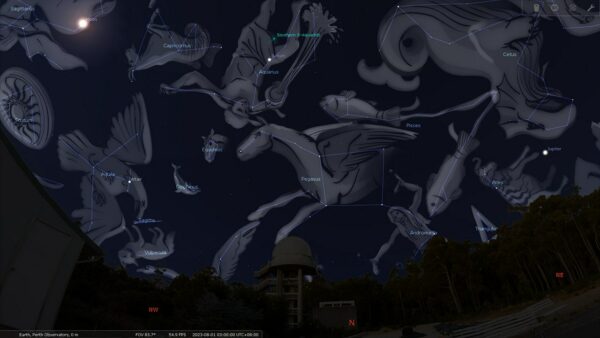
|
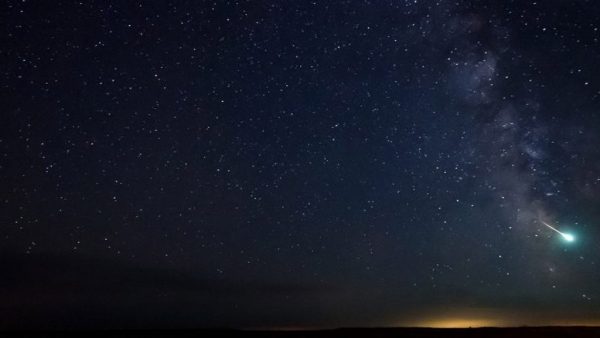
|
Things To Look At This Month:
Hercules Globular Cluster:
The Hercules Cluster, also known as Messier 13 (M13) and NGC 6205, is an impressive Globular Cluster situated approximately 22-25,000 light-years away from Earth within the constellation of Hercules (The son of Zeus). Spanning about 168 light-years in diameter, this cluster boasts several hundred thousand stars with an astonishing age of 11.5 billion years. The stars within the M13 population are remarkably densely packed, over a hundred times more so than those in the Sun’s vicinity. This close proximity sometimes leads to stellar collisions, giving rise to the formation of new stars known as “Blue Stragglers”.
First discovered by Edmond Halley in 1714, Messier 13 was later catalogued by Charles Messier in his renowned collection of celestial objects that should not be mistaken for comets. When observed through binoculars, the Hercules Globular Cluster appears as a circular patch of radiant light, while a telescope with a diameter of at least 4″ allows for the resolution of individual stars within M13’s outer regions, appearing as minute pinpoints of light.
An intriguing event involving the Hercules Cluster took place in 1974 when the Arecibo message was transmitted from the Arecibo Observatory. This message contained encoded information encompassing details about the human race, DNA, atomic numbers, Earth’s position, and more, serving as an experiment to establish contact with potential extraterrestrial civilizations residing in the cluster. However, due to the cluster’s motion through space, there is uncertainty regarding whether the message will eventually reach its intended destination and be received by the inhabitants of Messier 13.
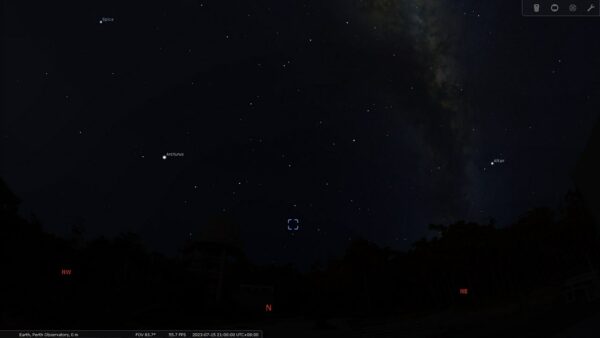
|
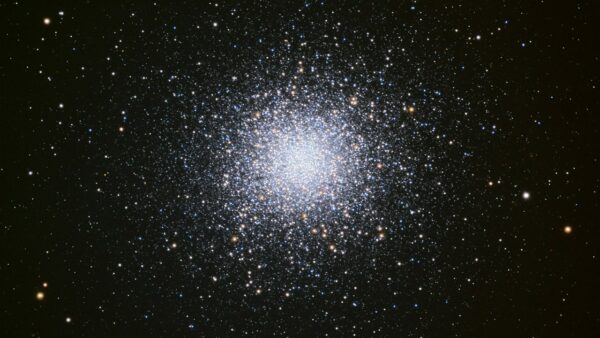
|
Wild Duck Cluster:
The Wild Duck Cluster, also known as Messier 11 (M11) and NGC 6705, is an open cluster situated 6,120 light-years away in the constellation of Scutum (the Shield). Renowned for its richness and compactness, M11 is among the most massive open clusters, spanning a diameter of 190 light-years and containing over 2,900 stars estimated to be around 316 million years old. The cluster was initially discovered by Gottfried Kirch in 1681, and its name originates from the arrangement of brighter stars resembling a flying flock of ducks. Notably, M11 holds the distinction of being the most distant open cluster visible to the naked eye among the 26 included in the Messier catalogue.
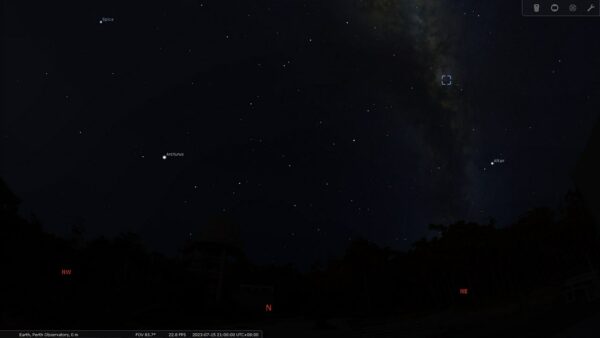
|
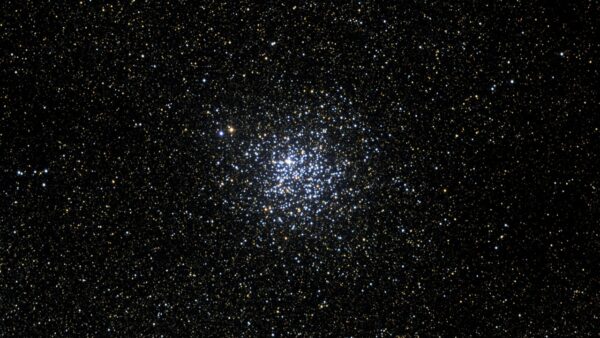
|
Butterfly Cluster:
The Butterfly Cluster, also referred to as Messier 6 (M6) and NGC 6405, is an open cluster comprised of approximately 120 stars located within the constellation of Scorpius (The Scorpion). Positioned around 1,600 light-years away from Earth, the stars within this cluster are estimated to be between 55 and 100 million years old. Visually, the Butterfly Cluster appears slightly smaller than a Full Moon, with dimensions measuring 12 light-years in width and 25 light-years in length. It is crucial to avoid confusing M6 with its brighter neighbour, M7, situated southeast of it.
While the discovery of the Butterfly Cluster by Giovanni Hodierna predates 1654, his data was not unearthed until the 1980s. It was independently discovered by Philippe de Chesaeux in 1745/6, and Messier officially catalogued it as M6 in 1764. Remarkably, as of January 2022, the Butterfly Cluster remains one of the few objects within the Messier Catalogue yet to be photographed by the Hubble Space Telescope.
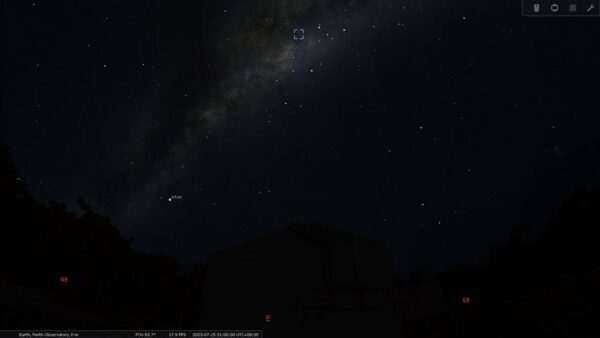
|
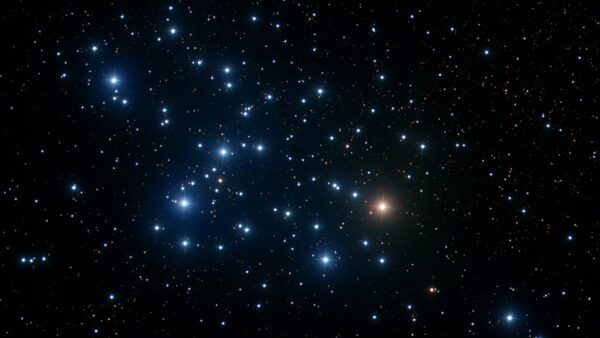
|
DY Crucis:
DY Crucis is a Carbon Star located in close proximity to Mimosa (Beta Crucis) and the Jewel Box Cluster (NGC 4755) in the constellation of the Crux (The Southern Cross), positioned 4,077 light-years away from Earth. A Carbon Star represents a giant star in the later stages of its evolution. While sharing similarities with red giants, Carbon Stars possess atmospheres with higher carbon-to-oxygen ratios. They often exhibit variability, altering their size and brightness over time.
DY Crucis captivates observers with its distinctive cherry red hue, a result of its atmosphere containing carbon “soot” in the form of carbon and carbon compounds. This soot scatters and reflects blue light while allowing red light to pass through, similar to the phenomenon observed during sunsets. Furthermore, the star’s surface temperature contributes to its appearance, as DY Crucis registers below 3,500 Kelvin, classifying it as a cool star and lending it a reddish tone. To provide context, the temperature of our Sun is approximately 5,778 Kelvin.
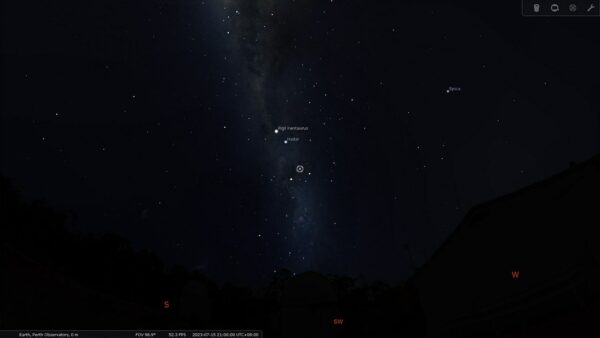
|
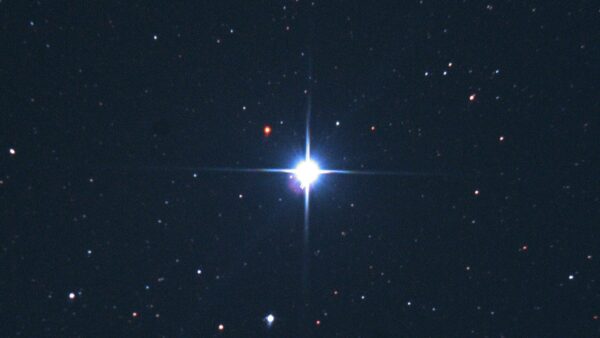
|
Phases Of The Moon:
